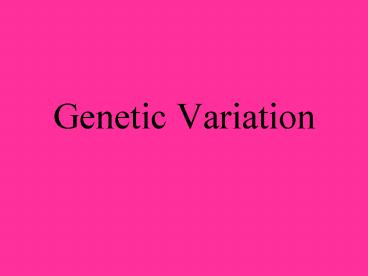Genetic Variation - PowerPoint PPT Presentation
1 / 15
Title: Genetic Variation
1
Genetic Variation
2
The Law of Segregation
- Mendels 1st Law
- The 2 alleles of each gene pair separate into
different gametes (egg or sperm) during meiosis.
3
The Law of Independent Assortment
- Mendels 2nd Law
- Independent Assortment
- Genes that are inherited separately Do NOT
influence the inheritance of others - Alleles segregate independently during meiosis
- Some ALLELES go to one gamete and some to another
4
INCOMPLETE DOMINANCE
- Incompletely dominance
- Genes are neither dominant nor recessive they
mix!!! - Genotype is heterozygous (hybrid--Hh)
- Phenotype is between two parents
- Dominant gene cannot fully mask the recessive
- Ex white flower x red flower pink flowers
5
CODOMINANCE
- Codominance
- Offspring shows phenotype of neither parent
- Both alleles are DOMINANT!!!
- Ex black chicken x white chicken checkered
chicken
6
MULTIPLE ALLELES
- Multiple alleles (Polygenic Traits
- Two OR More alleles control a trait
- You still will only have two of these alleles.
- Ex height, hair color, eye color and blood type
- There are 3 different alleles for blood
- IA (Type A) IA IA or IA i
- IB (Type B) IB IB or IB I
- IA IB (Type AB) IA IB
- ii (Type O) ii
7
Sex-Linked Alleles
- Sex-linked alleles
- controlled by genes located on sex chromosomes
(XX or XY) - Usually carried on X chromosome
- Since females are XX, they are usually carriers
of the trait - Since males are XY, they have a higher tendency
for inheritance of trait
8
- If trait is X-linked, MALES
- pass it to all daughters
- none to sons
- If trait is X-linked, MOTHERS
- have 50/50 chance of passing it to all of their
children - Ex colorblindness, hemophilia, male pattern
baldness
9
Mutations
- Mutation
- Any mistake or change in the DNA sequence
- Point mutation
- Change in one nitrogen base inDNA
- Ex albinism
10
Chromosomal Mutation
- Changes in chromosome structure
- 1) INVERSION
- the order of genes on a chromosome is inverted
- 2) TRANSLOCATION
- the movement of a chromosome fragment to a
nonhomologus chromosome
11
- 3. DELETION
- Loss of a few bases
- Loss of large regions of a chromosome
- 4. DUPLICATION
- Duplication of a few bases
- Duplication of large regions of a chromosome
12
Crossing Over
- Occurs when chromosomes exchange genes.
- 2 chromosomes overlap.
- Some genes cross over and switch places
13
NONDISJUNCTION
- Nondisjunction
- chromosome pair fails to separate properly during
meiosis - Monosomy
- gamete has 1 less chromosome than it should
- 45 chromosomes is the result
- Ex Turner syndrome
- Missing a sex chromosome
14
- Trisomy
- Gamete has 1 more chromosome than it should
- Result is 47 chromosomes
- Ex Downs Syndrome
- Extra 21 chromosome
15
Methods of Detection
- Chorion villi sampling
- Take sample of the chorion
- (membrane surrounding fetus)
- Chemical tests and Karyotyping performed
- Ultrasound
- Sound waves are used to generate an image of the
unborn child. - Used to detect abnormalities of limbs, organs,
etc.
- Amniocentesis
- Fluid surrounding the fetus is drawn out by
needle - Fetal cells are collected and grown in a lab.
- Chromosomes can be then Karyotyped































